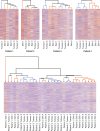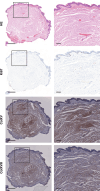Mass spectrometric insights into the protein composition of human cutaneous neurofibromas: comparison of neurofibromas with the overlying skin
- PMID: 40394150
- PMCID: PMC12322300
- DOI: 10.1038/s41416-025-03055-9
Mass spectrometric insights into the protein composition of human cutaneous neurofibromas: comparison of neurofibromas with the overlying skin
Abstract
Background: Cutaneous neurofibromas (cNFs) are the hallmark of the tumor-predisposition syndrome neurofibromatosis 1 (NF1). While cNFs are always benign, they markedly decrease quality of life in individuals with NF1. Understanding the differences between cNFs and the skin is essential for developing treatments for cNFs.
Methods: We collected 15 cNFs from four NF1 individuals and used mass spectrometry to compare the tumor tissue with the skin overlying each tumor. Data were analyzed based on Gene Ontology (GO) terms.
Results: The expression patterns of the Schwann cell marker S100B and several keratins confirmed successful dissection of cNF tissue from the overlying skin. Hierarchical clustering showed extensive overlap between the tumor and skin samples in three out of four individuals, suggesting high overall similarity between the two tissue types. Based on the analysis of the GO terms, cNFs were associated with decreased expression of proteins related to cell proliferation, extracellular matrix remodeling, angiogenesis and cellular metabolism.
Conclusion: The cNFs are relatively quiescent, consistent with their benign nature and limited growth potential. The development of pharmacological therapy for cNFs requires overcoming the high similarity between cNFs and the overlying skin. The present dataset can serve as a resource for future research on cNFs.
© 2025. The Author(s).
Conflict of interest statement
Competing interests: The authors declare no competing interests. Ethics approval and consent to participate: The study adhered to the principles of the Declaration of Helsinki and was approved by the Ethics Committee of the Hospital District of Southwest Finland (131/1803/2017), and Turku University Hospital. All participants provided their written informed consent.
Figures


Similar articles
-
Unraveling the development of cutaneous neurofibromas in neurofibromatosis type 1.Acta Neuropathol Commun. 2025 Jul 19;13(1):158. doi: 10.1186/s40478-025-02075-z. Acta Neuropathol Commun. 2025. PMID: 40684195 Free PMC article.
-
Unbalancing cAMP and Ras/MAPK pathways as a therapeutic strategy for cutaneous neurofibromas.JCI Insight. 2024 Jan 4;9(3):e168826. doi: 10.1172/jci.insight.168826. JCI Insight. 2024. PMID: 38175707 Free PMC article.
-
Prevalence and clinicopathological characteristics of lipomatous neurofibromas in neurofibromatosis 1: An investigation of 229 cutaneous neurofibromas and a systematic review of the literature.J Cutan Pathol. 2018 Oct;45(10):743-753. doi: 10.1111/cup.13315. Epub 2018 Aug 1. J Cutan Pathol. 2018. PMID: 29959804
-
Systemic treatments for metastatic cutaneous melanoma.Cochrane Database Syst Rev. 2018 Feb 6;2(2):CD011123. doi: 10.1002/14651858.CD011123.pub2. Cochrane Database Syst Rev. 2018. PMID: 29405038 Free PMC article.
-
Enhanced CXCL10 expression in mast cells for cutaneous neurofibroma presenting with pain and itch.Br J Cancer. 2025 Apr;132(7):611-621. doi: 10.1038/s41416-025-02956-z. Epub 2025 Feb 20. Br J Cancer. 2025. PMID: 39979642
References
-
- Gutmann DH, Ferner RE, Listernick RH, Korf BR, Wolters PL, Johnson KJ. Neurofibromatosis type 1. Nat Rev Dis Prim. 2017;3:17004. - PubMed
-
- DeBella K, Szudek J, Friedman JM. Use of the national institutes of health criteria for diagnosis of neurofibromatosis 1 in children. Pediatrics. 2000;105:608–14. - PubMed
-
- Duong TA, Bastuji-Garin S, Valeyrie-Allanore L, Sbidian E, Ferkal S, Wolkenstein P. Evolving pattern with age of cutaneous signs in neurofibromatosis type 1: a cross-sectional study of 728 patients. Dermatology. 2011;222:269–73. - PubMed
Publication types
MeSH terms
Substances
Grants and funding
LinkOut - more resources
Full Text Sources
Medical
Research Materials
Miscellaneous

